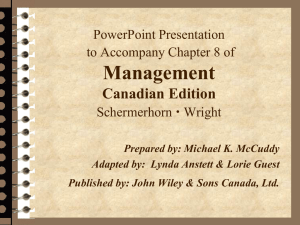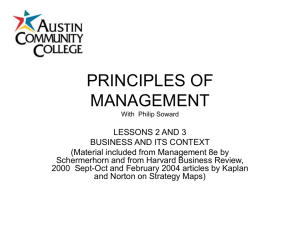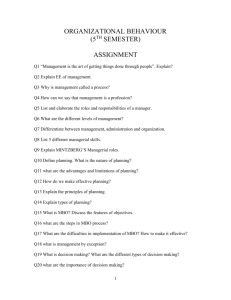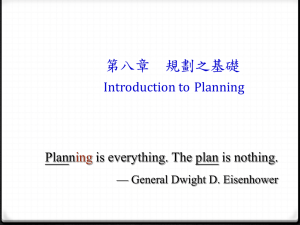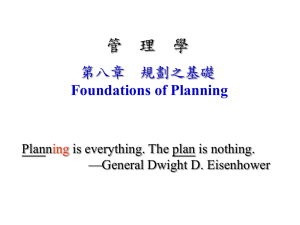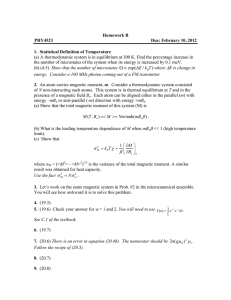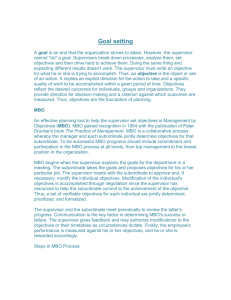PLANNING AND CONTROLLING CHAPTER 8 1
advertisement
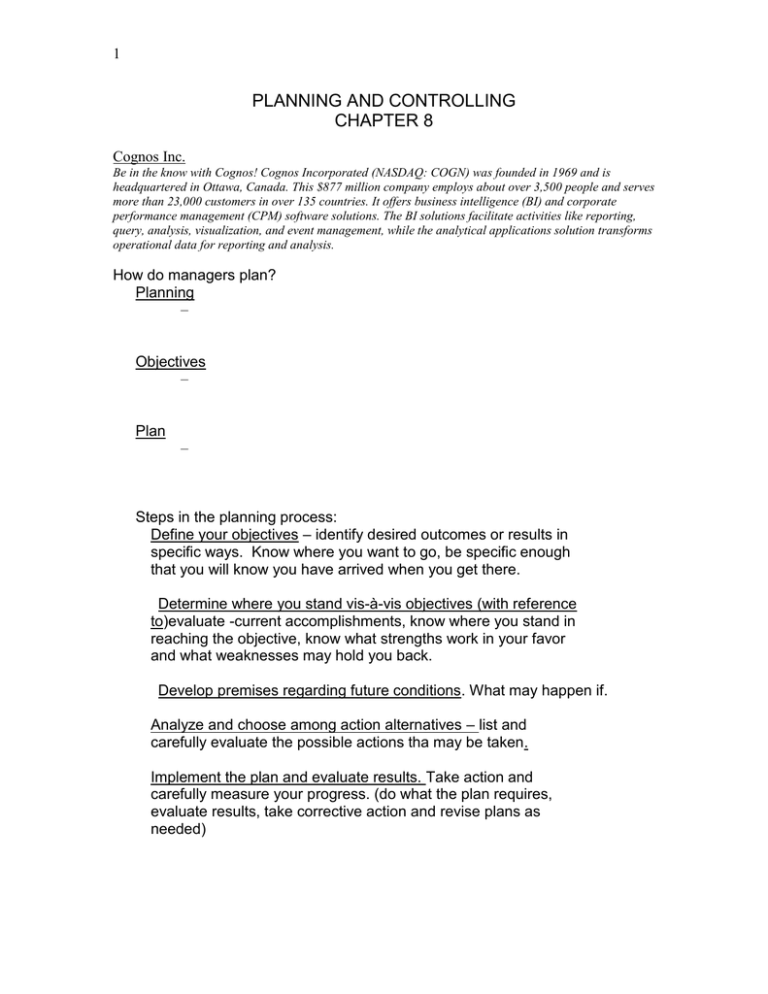
1 PLANNING AND CONTROLLING CHAPTER 8 Cognos Inc. Be in the know with Cognos! Cognos Incorporated (NASDAQ: COGN) was founded in 1969 and is headquartered in Ottawa, Canada. This $877 million company employs about over 3,500 people and serves more than 23,000 customers in over 135 countries. It offers business intelligence (BI) and corporate performance management (CPM) software solutions. The BI solutions facilitate activities like reporting, query, analysis, visualization, and event management, while the analytical applications solution transforms operational data for reporting and analysis. How do managers plan? Planning – Objectives – Plan – Steps in the planning process: Define your objectives – identify desired outcomes or results in specific ways. Know where you want to go, be specific enough that you will know you have arrived when you get there. Determine where you stand vis-à-vis objectives (with reference to)evaluate -current accomplishments, know where you stand in reaching the objective, know what strengths work in your favor and what weaknesses may hold you back. Develop premises regarding future conditions. What may happen if. Analyze and choose among action alternatives – list and carefully evaluate the possible actions tha may be taken. Implement the plan and evaluate results. Take action and carefully measure your progress. (do what the plan requires, evaluate results, take corrective action and revise plans as needed) 2 Benefits of planning: – Improves focus and flexibility – – Improves action orientation- – Improves coordination – – Improves time management – – Improves control – What types of plans do managers use? Short-range and long-range plans – Short-range plans = 1 year or less – Intermediate-range plans = 1 to 2 years – Long-range plans = 3 or more years People vary in their capability to deal effectively with different time horizons. Higher management levels focus on longer time horizons. Strategic and operational plans Strategic plans — set broad, comprehensive, and longer-term action directions for the entire organization. Operational plans — define what needs to be done in specific areas to implement strategic plans. 1. Production plans – 2. Financial plans – 3. Facilities plans – 4. Marketing plans – 5. Human resource plans – 3 Policies and procedures Standing plans -Policies and procedures that are designed for repeated use. Policy -Broad guidelines for making decisions and taking action in specific circumstances. Rules or procedures -Plans that describe exactly what actions are to be taken in specific situations. Budgets and project schedules Single-use plans – Budgets -single- Fixed, flexible, and zero-based budgets – Projects – Project management and project schedules- What are the useful planning tools and techniques? Forecasting – Making assumptions about what will happen in the future. – Qualitative forecasting uses expert opinions. – Quantitative forecasting uses mathematical and statistical analysis. – All forecasts rely on human judgment. – Planning involves deciding on how to deal with the implications of a forecast. Contingency planning – Identifying alternative courses of action that can be implemented to meet the needs of changing circumstances. – Contingency plans anticipate changing conditions. – Contingency plans contain trigger points. Scenario planning – A long-term version of contingency planning. – Identifying alternative future scenarios. – Plans made for each future scenario. – Increases organization’s flexibility and preparation for future shocks. 4 Benchmarking - The purpose is to find out what other people and organizations are doing very well and plan how to incorporate these ideas into one’s own operations. – Use of external comparisons to better evaluate current performance and identify possible actions for the future. – Adopting best practices of other organizations that achieve superior performance. Use of staff planners – Coordinating the planning function for the total organization or one of its major components. – Possible communication gaps between staff planners and line management. – Lead and coordinate the planning function – Assist line managers in preparing plans – Gathering and maintaining planning information – Assisting in communicating plans – Monitor plans in progress and suggest changes. Participation and involvement – Participatory planning requires that the planning process include people who will be affected by the plans and/or will help implement them. – Benefits of participation and involvement: • Promotes creativity in planning. • Increases available information. • Fosters understanding, acceptance, and commitment to the final plan. What is the control process? Controlling – The process of measuring performance and taking action to ensure desired results. – Has a positive and necessary role in the management process. – Ensures that the right things happen, in the right way, at the right time. – Organizational learning and after-action review. Steps in the control process: – Step 1 — establish objectives and standards. – Step 2 — measure actual performance. – Step 3 — compare results with objectives and standards. – Step 4 — take corrective action as needed. 5 Step 1 — establishing objectives and standards – Output standards – – Input standards – Step 2 — measuring actual performance – Goal is accurate measurement of actual performance results and/or performance efforts. – Must identify significant differences between actual results and original plan. – Effective control requires measurement. Step 3 — comparing results with objectives and standards – Need for action reflects the difference between desired performance and actual performance – Comparison methods: • Historical comparison – • Relative comparison – • Engineering comparison – Step 4 — taking corrective action – Taking action when a discrepancy exists between desired and actual performance. – Management by exception • Giving attention to situations showing the greatest need for action. • Types of exceptions – Problem situation – – Opportunity situation – 6 Feedforward controls – Employed before a work activity begins. – Ensures that: • • • – Focuses on quality of resources. Concurrent controls – – – Feedback controls – Take place after work is completed. – Focus on quality of end results. – Provide useful information for improving future operations Internal and external control – Internal control • – External control What are the common organizational controls? Management by Objectives (MBO) – A structured process of regular communication. – Supervisor/team leader and workers jointly set performance objectives. – Supervisor/team leader and workers jointly review results. MBO involves a formal agreement specifying – Workers’ performance objectives for a specific time period. – Plans through which performance objectives will be accomplished. – Standards for measuring accomplishment of performance objectives . – Procedures for reviewing performance results. 7 The MBO process: – Supervisor and workers jointly set objectives, establish standards, and choose actions. – Workers act individually to perform tasks; supervisors act individually to provide necessary support. – Supervisor and workers jointly review results, discuss implications, and renew the MBO cycle. Types of MBO performance objectives – – – Criteria for effective performance objectives – – – – Pitfalls to avoid in using MBO – Tying MBO to pay. – Focusing too much attention on easily quantifiable objectives. – Requiring excessive paperwork. – Having managers tell workers their objectives Employee discipline systems – Discipline is the act of influencing behavior through reprimand. – Discipline that is applied fairly, consistently, and systematically provides useful control. To be effective, reprimands should – – – – – – Employee discipline systems – Progressive discipline ties reprimands to the severity and frequency of the employee’s infractions. – Progressive discipline seeks to achieve compliance with the least extreme reprimand possible. 8 Important financial aspects of organizational performance – Liquidity – Leverage – Asset management – Profitability - Break-even analysis – Determination of the point at which sales revenues are sufficient to cover costs. – Break-Even Point = Fixed Costs / (Price – Variable Costs) – Used in evaluating: • New products • New program initiatives Purchasing control – A productivity tool – Trends in purchasing control: • Leveraging buying power • Committing to a small number of suppliers • Working together in supplier-purchaser partnerships Inventory control – Goal is to ensure that inventory is just the right size to meet performance needs, thus minimizing the cost. – Methods of inventory control: • Economic order quantity • Just-in-time scheduling Statistical quality control – Quality control involves checking processes, materials, products, and services to ensure that they meet high standards. – Statistical quality control involves: • Taking samples of work. • Measuring quality in the samples. • Determining the acceptability of results.
